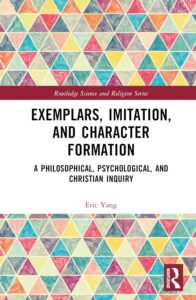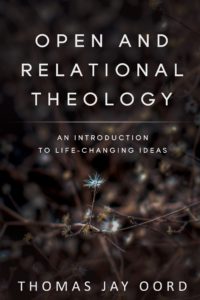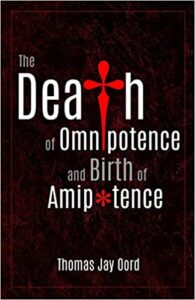Imitating God
An essay I wrote on imitating God has just been published.
My essay is in an academic book called Exemplars, Imitation, and Character Formation (Routledge). Eric Yang is the book’s editor, and contributors examine the relevance of exemplars and the practice of imitation in character formation.
My arguments use Ephesians 5:1,2a as a springboard. This letter attributed to the Apostle Paul says, “Imitate God, as dearly beloved children, and live a life of love, as Christ loved us…”
A good portion of my essay criticizes Augustine’s love theology for not being able to provide a basis to make sense of imitating God. I also criticize Thomas a’ Kempis’s famous book The Imitation of Christ, because it assumes the validity of Augustinian love theology. (Here’s a bit of that section in a previous blog.)
Below is the second half of my essay. I argue that imitating God makes sense in open and relational theology.
An Open and Relational God
Open and relational theology offers a better framework for imagining how humans might imitate God. While the framework is broad, those who adopt it share a common commitment to thinking God and creatures are relational and the future is open.
By “relational,” open and relational theologians believe God is an agent who gives and receives with creatures. God is passible. As an experiencer, God influences others, and others influence God. Rather than being entirely dissimilar, therefore, Creator and creatures share the ability to act and relate.
By “open,” open and relational theologians believe God experiences time moment by moment, analogous to how creatures experiences time. Rather than timeless, God is “inside” time and everlasting. The past is the past for God and creation; present is present; the future is open and yet to be determined.
Open and relational theologians say God’s acting is like creaturely acting, at least in some ways. The basic meanings of “act,” “relate,” “experience,” and “love” apply to Creator and creatures; God exemplifies the ontological principles of existence.[1] To put it another way, divine action is not entirely different nor mysterious. God is part of the causal network of existence as one cause among others.
Differences between Creator and creation exist, of course. God experiences everlastingly, for instance, while creaturely experiencing is temporary. God relates with all, but no creature can relate with all others. God loves by nature; creatures can choose whether to love. And so on.
God is transcendent and immanent: different from creatures in some ways, but like them in others. Without similarities, we cannot make constructive claims about how God and creatures love. Without differences, we cannot distinguish the Creator from creatures. But without similarities, we cannot imitate God.
Detecting the God Who Can Be Imitated
God’s invisibility and universality raise obstacles that must be overcome when formulating an imitatio dei theology. To offer a coherent view of divine exemplarity, we need to overcome those obstacles. I offer conceptual tools below to do so.
Our five senses cannot perceive an invisible and incorporeal spirit. “No one has seen God,” to cite scripture again. We can’t literally see God walking in the garden, for instance. Our eardrums literally don’t vibrate in response to sounds from divine vocal cords. We cannot see, taste, hear, smell, or touch a spiritual being.[2]
Biblical writers sometimes talk about encounters with an embodied God, of course. God walked in the garden with Adam and Eve, Genesis tells us (Gen. 3). Jacob wrestled with the Lord (Gen. 32), and Moses saw God’s butt (Exod. 33). John heard a voice from heaven saying, “This is my beloved Son. Listen to him” (Mt. 3:17). And so on.
If God’s being or composition is spiritual, however, these descriptions cannot be literally true. God doesn’t literally have a body and doesn’t literally walk, speak, get red in the face, kiss, and so on. Scriptures that say God does such activities are metaphorical. Metaphors are important but should not be interpreted literally.
Believers are right to assume the Spirit’s action behind or beneath something we admire, respect, or esteem. When we see a beautiful sunset, a doe licking her newborn fawn, a soldier turning the other cheek, an act of kindness for an elderly person, and more, theists might infer that the Spirit inspired each. A loving, good, true, and beautiful Spirit inspires but does not entirely cause everything loving, good, true, and beautiful that occurs in the world.
Theists can do more than infer God’s activity behind what they observe, however. Open and relational theologians argue for access to God that involves nonsensory perception.[3] This way of knowing provides knowledge of other aspects of life, like causation, values, emotions, freedom, and more. It also assumes a robust empiricism, which says we draw from experience to know our world and God’s activity.
John B. Cobb, Jr. explains it like this, “If God is present and working in us, . . . there is nonsensory perception of God all the time . . . Instead of speaking of new spiritual senses, we can think of nonsensuous experience of the divine presence in our lives and awareness of its salvific effects.”[4] In short, nonsensory perception detects the actions of the Spirit.
The idea of nonsensory perception fits the language of theists who talk about encounters with God. Believers speak of detecting the divine, for instance, as a “still small voice,” “intuition,” a “feeling” a “holy nudge,” an “inclination,” one’s “moral compass,” a “hunch,” an “inkling,” “divine insight,” an inaudible “call,” a “light,” our “better angels,” one’s conscience, and more. Although not fully accurate, this language describes the direct perception of the Spirit. I address this in more detail in my book The Death of Omnipotence and Birth of Amipotence.
To sum up, our sense perceptions cannot detect what an invisible Spirit does. This creates obstacles to imitating God. We can infer the Spirit’s activities, however. We directly detect God’s activity through nonsensory perception. This detection of divine action helps as we consider what it means to imitate God.[5]
What is Love?
Having cleared some conceptual obstacles, I return to the Apostle Paul’s advice to imitate God. In the sections leading up to “be imitators of God,” Paul points to moral issues, virtues and, in particular, love. Immediately following the charge to imitate God, Paul writes, “walk in love, as Christ loved us and gave himself up for us, a fragrant offering and sacrifice to God” (5:1-2).
Paul thinks his readers can imitate God by “walking” in love. Other translations say, “live a life of love.” “Walking” does not literally mean using legs. It refers to acting in love. But if we are to imitate divine love, we must have some clarity about what love is.
I find it helpful to define love in the following way: to love is to act intentionally, in relational response to God and others, to promote overall well-being.[6] To put it another way, love purposefully acts in relationships to foster flourishing.
To clarify this definition, I address its three clauses. The phrase “to act intentionally” points to action and motives. Love is not simply a feeling, although feelings often play a role in acts of love. A lover does something. And an act of love involves some deliberation, even if this deliberation is fleeting.
The phrase “to act intentionally” addresses intentions. A lover acts purposely. We should not regard an action loving if accidental. Acts done with the motive to harm should not be labeled “acts of love,” for instance, even if they have beneficial consequences. To put it another way, the lover acts prospectively, hoping to promote well-being. Motives matter.
I also use “to act intentionally” to account for the self-determination—freedom—inherent in love. Lovers are choosers and, to some degree, responsible for their actions. Freedom is always limited, however. Concrete circumstances, environmental constraints, bodily factors, genetics, neurology, historical pressures, and other conditions limit what is genuinely possible at any moment.[7] But acts of love require that lovers have genuine, albeit limited, freedom.
The phrase “in relational response to God and others” covers a range of important issues. The relational aspect suggests love requires more than one. Agents beyond the lover influence her. Love is relational; lovers respond.
Love includes, but is more than desire. To express love, in fact, we must sometimes act contrary to our desires, yearnings, or wants. We might have a strong desire to get revenge, for instance, but love calls us to forgive. We might want to express ourselves sexually in an illicit way, but love calls us to exert self-control.
My reference to God in this love definition points to the conviction that we cannot understand love well without reference to divine activity. God is the source of love and acts in each moment to empower and inspire creaturely love. God also relationally receives information, feelings, and activities, and then God responds by empowering and calling creatures to seek the common good.[8] To put it in the Apostle John’s language, we love because God first loves us (1 Jn 4:19).
While God is the source, power, and inspiration for creaturely love, God is not love’s sufficient cause.[9] Lovers relate to creaturely others. The “others” to whom lovers respond need not be human. We can respond to animals, other creatures, our environments, and more. Whether our love can or will be reciprocated by others is another issue.
The last phrase of my love definition, “to promote overall well-being,” points to the beneficial consequences at which love aims. Overall well-being includes the good of enemies and strangers, families and friends, societies, animals, other creatures, inanimate creation, and basic elements of existence. Even God’s well-being is enhanced by love. Love enhances multifarious dimensions of existence.[10]
The word “overall” suggests that our assessment of how love promotes good includes but reaches beyond our own good. “Self-love” has an appropriate place in the economy of “overall well-being.” But sometimes love also requires self-sacrifice. A life well lived includes many aspects of well-being.
The aim for “overall” well-being points to the justice dimension of love. Actions that privilege the few to the detriment of the whole are not loving. Actions that deny basic rights and goods are also not loving. Cornel West is fond of saying justice is what love looks like in public.[11] I like to say love seeks overall flourishing, and acting for the common good seeks justice for all.
Conclusion: We Can Imitate God When We Love
I’m ready now to bring together my arguments. Here are bullet point summaries of what I’ve argued above:
Open and relational theology says both God and creatures are relational.
God and creatures act moment by moment and move into an open future.
Because open and relational theology claims similarities exist between God and creatures, it provides a framework to make sense of imitating God by loving like God loves.
Although God is universal, invisible, and incorporeal, God acts relates, and loves analogously to how creatures act, relate, and love.
Love is best defined as acting intentionally, in relational response to God and others, to promote overall well-being.
Because creatures share similarities with God and because the definition of love applies to creatures and the Creator, we can imitate God.
In an open and relational theological framework, therefore, Paul’s admonition to his readers in Ephesus makes sense. It’s attainable. We imitate God when we act intentionally, in relational response to God and others, to promote overall well-being. The God who loves persistently is our example of what it means to love well.
Imitating God makes sense in open and relational theology.
[1] I agree with Alfred North Whitehead on this point. See Process and Reality: An Essay in Cosmology, corrected edition, ed. David Ray Griffin and Donald W. Sherburne (New York: Free, 1978; orig. ed., 1929), 521.
[2] An important exploration of what it means to perceive God is found in William P. Alston’s, Perceiving God: The Epistemology of Religious Experience (London: Cornell University Press, 1991).
[3] For details on nonsensory perception of God, see David Ray Griffin, Founders of Constructive Postmodern Philosophy: Pierce, James, Bergson, Whitehead, and Hartshorne (Albany, N.Y.: State University of New York Press, 1993). See also John B. Cobb, Jr., Grace and Responsibility: A Wesleyan Theology for Today (Nashville: Abingdon, 1995).
[4] Cobb, Grace and Responsibility, 75. I compare Wesley’s view of spiritual sensations with nonsensory perception in “Grace and Social Science: Nonsensory Perception of God in a Constructive Postmodern Wesleyan Philosophy,” Jnanadeepa: Pune Journal of Religious Studies, 5.2 (July 2002): 121-135.
[5] Many of these ideas and more are elaborated in Thomas Jay Oord, The Death of Omnipotence and Birth of Amipotence (Grasmere, Id.: SacraSage, 2023).
[6] I provide a more expansive explanation of this love definition in Defining Love: A Philosophical, Scientific, and Theological Engagement (Grand Rapids, Mich.: Brazos, 2010) and Pluriform Love.
[7] Daniel Day Williams makes this point nicely in The Spirit and Forms of Love (New York: Harper and Row, 1968), 116.
[8] I explain what it means for God to be the ideal recipient and contributor in Defining Love, ch. 6.
[9] I address the importance of denying that God can act as a sufficient cause in The Uncontrolling Love of God, ch. 7.
[10] Partha Dasgupta uses the phrase “pluralist outlook” for what I call the multifarious dimensions of existence. See his book, Human Well-Being and the Natural Environment (Oxford: Oxford University Press, 2001), 14.
[11] Cornel West, The American Evasion of Philosophy (Madison, Wis.: University of Wisconsin Press, 1989), 271.





Comments
i liked this essay a LOT. In the deconstruction of my own soteriology, I’ve landed squarely in the moral exemplar theory based largely on how Jesus himself referenced “soza” as his followers. My own trinitarian theology involves our shared imago dei I regard of Spirit, Mind, Body (Holy Spirit, Father, Son) where as we put on the mind of Christ and thus both think and act like Jesus ( vine and branch bearing fruit metaphor).